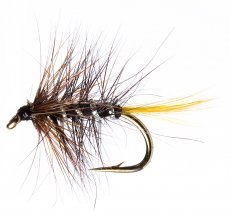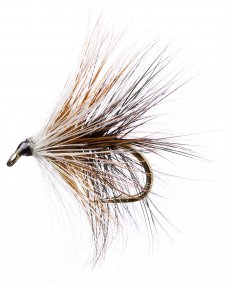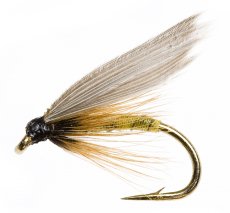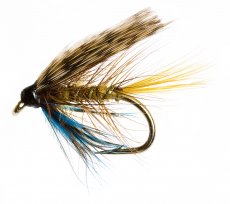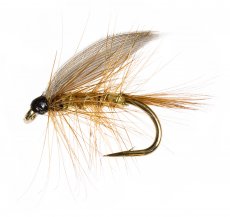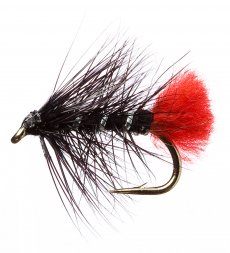Fly recommendation for Scottish traditional style by Sandy Forgan.
KATE MCLAREN: invented by Charles McLaren and named in honour of his wife, this fly is the archetypal black midge, but possesses a tail that also gives it an 'upwing fly' dimension. It has several of the elements that many successful modern flies possess - the attraction of a black body ribbed with silver is undeniable. Fish this fly with confidence on the bob especially if the dressing is bushy, or lower down in a lighter dressing. It catches rainbows and brownies and is a great Scottish export to all parts of the world.
KE-HE: an Orcadian pattern invented in the 1930s, the 'Ke-He' is a fly that will successfully catch trout anywhere. I have used it in Australia and in Scandinavia as well as in countless lochs in Scotland. I find that it works well as a point fly or as a bob-fly when it is nice and fluffy. Although it is a bit of a nondescript pattern, based on ancient patterns, it is none the worse for this because the Ke-he has proven to be highly effective, on many occasions.
LOCH ORDIE: in the rolling heathery hills above Dunkeld another top fly was designed for use in Perthshire. The Loch Ordie fly is used as a dapping pattern and as a bob fly, usually with great success. Older tyings for dapping had a 'flying treble' hook, but this elaboration is missing from standard wet fly dressings.
CLAN CHIEF: the Clan Chief deserves its noble name but if Captain John Kennedy had known just how successful his creation would become, he might have been justified in calling it the Ard Righ - the gaelic title for the King of Scotland. The Clan Chief was originally designed for use in the machair lochs of the Western Isles, especially South Uist. However, in recent years it has become a firm favourite on all rainbow and brown trout waters. The amalgamation of black and claret colours, with silver ribbing and the brightly coloured tail, attracts trout marvellously. A bushily tied pattern is the ideal bob-fly. This is a relatively recent pattern, but one which has established itself within the ranks of traditionally-styled patterns due to its remarkable effectiveness.
GROUSE AND CLARET: the quintessential Scottish fly pattern that catches trout wherever it is used. Overall, the Grouse and Claret is used to represent flies from each of the main aquatic fly orders but its imitativeness really does not matter, for it is taken by trout as avidly as any other traditional pattern. Its near cousin, the 'Mallard and Claret', is almost as successful but in Scotland the wing feathers of the Highland grouse are used to create the fly pattern.
SILVER INVICTA: this is a classic fly by any standard and probably represents small fry or sticklebacks. It may also represent the film of silvery air bubbles which exudes from the hatching pupae of many aquatic flies as they ascend to the surface to eclose. Whatever the reason for its effectiveness, it is a fly that Scottish anglers should never be without. It makes the best middle-placed fly on a three (or four) fly cast. Brownies will readily accept Silver Invictas, providing they are the right size, smaller as the season progresses, but bigger on dark, windy days. Sea trout and rainbows are attracted to the Silver Invicta.
DUNKELD: on the banks of the River Tay stands the lovely small town of Dunkeld. Trout and salmon swim in its waters; the popular golden-orange 'Dunkeld' can be used successfully here. It is not an imitative pattern - there are few flies with a golden body and hot orange legs - but it is an effective attractor. Fish it anywhere on bright days in clear water, following the rule 'bright day - bright fly'. Also fish it on dark days and when the water is less clear, for it shines like a beacon, and trout will only chase what they can see.
ALEXANDRA: an old but effective point fly, the Alexandra provides flash and colour contrast. It has accounted for innumerable sea trout and brownies, and is yet to be fully exploited as a pattern for rainbows.
MCLEOD'S OLIVE: very similar to the most wellknown fly, Canon Greenwell's Glory, McLeod's Olive is an old Scottish pattern. Designed to imitate the upwing natural flies, known by anglers as olives, McLeod's Olive should be used on the point, or middle position, in the cast and will work best when there are natural olives in the vicinity. It also works well when there are sedges hatching, especially if you are using a thicker version. In normal use, keep the dressing as slim and uncluttered as possible and you will have a genuine, traditional fish taker.
ZULU: the Zulu, or one of its many variations, is an essential inclusion in your traditional fly box. The standard Zulu is a great disturbance pattern when fished on the bob, but it works very well further down the cast (but remember to dress it slightly less densely). It successfully attracts rainbows and brownies and seems to benefit from a fore-hackle of light blue (the 'Blue Zulu') when used for sea trout.








